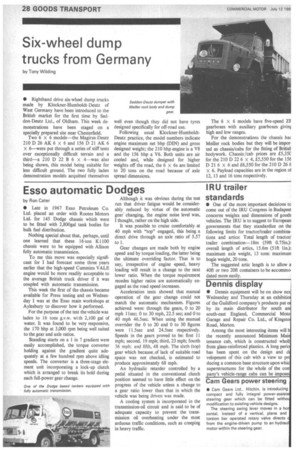Esso automatic Dodges
Page 30

If you've noticed an error in this article please click here to report it so we can fix it.
by Ron Cater • Late in 1967 Esso Petroleum Co. Ltd. placed an order with Rootes Motors Ltd. for 145 Dodge chassis which were to be fitted with 2,800gal tank bodies for bulk fuel distribution.
Nothing special about that, perhaps, until one learned that these 16-ton K1100 chassis were to be equipped with Allison fully automatic transmission.
To me this move was especially significant for I had forecast some three years earlier that the high-speed Cummins VALE engine would be more readily acceptable to the average British truck driver if it was coupled with automatic transmission.
This week the first of the chassis became available for Press testing and on Wednesday I was at the Esso main workshops at Aylesbury to discover how it performed.
For the purpose of the test the vehicle was laden to 16 tons g.v.w. with 2,100 gal of water. It was found to be very responsive, the 170 bhp at 3,000 rpm being well suited to the gear and axle ratios.
Standing starts on a 1 in 7 gradient were easily accomplished, the torque converter holding against the gradient quite adequately at a few hundred rpm above idling speeds. The converter is a three-stage element unit incorporating a lock-up clutch which is arranged to break its hold during each full-power gear change.
Although it was obvious during the test run that driver fatigue would be considerably reduced by virtue of the automatic gearchanging, the engine noise level was, I thought, rather on the high side.
It was possible to cruise comfortably at 40 mph with "top" engaged, this being a direct drive through an axle ratio of 5.57 to 1.
Gear changes are made both by engine speed and by torque loading, the latter being the ultimate overriding factor. That is to say, irrespective of engine speed, heavy loading will result in a change to the next lower ratio. When the torque requirement recedes higher ratios are automatically engaged as the road speed increases.
Acceleration tests showed that manual operation of the gear change could not match the automatic mechanism. Figures achieved were: through the gears, 0 to 20 mph 1 lsec; 0 to 30 mph, 22.5 sec; and 0 to 40 mph 46.5see. When using the manual overrider the 0 to 20 and 0 to 30 figures were 11.5sec and 24.5sec respectively. Speeds in the gears proved to be: first 11 mph; second, 19 mph; third, 23 mph; fourth 36 mph: and fifth, 48 mph. The sixth (top) gear which because..of lack of suitable road space was not checked, is estimated to produce approximately 68 mph.
An hydraulic retarder controlled by a pedal situated in the conventional clutch position seemed to have little effect on the progress of the vehicle unless a change to a gear ratio lower than that in which the vehicle was being driven was made.
A cooling system is incorporated in the transmission-oil circuit and is said to be of adequate capacity to prevent the transmission oil overheating under the most arduous traffic conditions, such as creeping in heavy traffic.












































































































